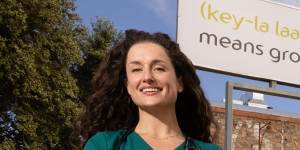Figures from the Royal Australian College of General Practitioners (RACGP) show that 1394 medical graduates applied to do general practice training in the College’s latest intake,a 30 per cent drop from almost 2000 applications in 2017.
“We are at serious risk of running out of GPs. Young graduate doctors have so many choices,but it is not attractive to them to pursue a career in general practice,” RACGP president Dr Karen Price said.

General practitioner Isabel Hanson is a locum doctor at the Maari Ma primary health care service in Broken Hill.Andrew Gosling
A Deloitte Access Economic report from 2019 found Australia is heading for a serious undersupply of GPs by 2030,with an anticipated shortfall of 9298 full-time GPs - or almost 25 per cent of the GP workforce - and urban areas likely to see the biggest drop-off.
Price said that while COVID-19 put the brakes on overseas doctors applying for training,the number of applications submitted to the College has been declining for years.
“We have a big workforce issue and general practice has suffered. The system is on the verge of collapse because of a lack of investment in primary care,” she said.
General practitioner Isabel Hanson,a locum at the Maari Ma primary health care service in Broken Hill,said young doctors are shunning GP training after seeing “how rushed primary care is... There isn’t enough time for high-quality medical care for complex patients”.
She chose general practice because of “the sense of meaning and satisfaction that comes from making a real difference in people’s lives,” whether that is picking up cancer early or providing care to the most vulnerable patients.
But Medicare cuts have gutted primary care,she said,pushing GPs to practise “fast medicine or charge a gap fee,which families on the poverty line can’t afford”.
“Fast medicine is like fast food. It isn’t good long term. If we keep going the way we are going we will see rising rates of diabetes,depression,heart disease and obesity,” she said. “A healthcare system cannot run on goodwill alone”.
Hanson said GPs need better access to parental leave and more GP academics teaching medical students at university:“Medical students don’t get taught by GPs,so they don’t imagine their future careers as one”.
“We have more chronic diseases now – like diabetes – and when they aren’t regularly checked people end up in emergency rooms.”
Lizz Reay,Wentworth Healthcare CEO
Government cuts to Medicare funding for GPs to interpret ECGs,which measures whether someone is having a heart attack or life-threatening irregular heart rhythm,was particularly concerning,she said.
University of Melbourne research published last year found non-GP specialists are earning almost twice as much as GPs. Incomes increased by 10.7 per cent for GPs (from $189,574 to $209,938) in the decade to 2018,while specialists increased by 21.5 per cent (from $338,554 to $411,575) over the same time.
Mount Druitt doctor Kean-Seng Lim said young medical trainees are choosing other specialist fields because of “lower remuneration compared to other medical specialties... and because general practice is also often portrayed poorly during medical school and hospital training,” Lim said.
Wentworth Healthcare CEO Lizz Reay said she had seen a steady decline in the number of GPs in Penrith and the Blue Mountains over the past five years - areas that now have two-week waiting lists.
“If we don’t work out why people are going into general practice to begin with,we won’t ever solve the problem. We will just keep shuffling doctors from region to region”.
She said Medicare fees have “been stagnant for so long”,and,after COVID-19,“we are just constantly hearing about GPs being completely burnt out”
“We have more chronic diseases now – like diabetes – and when they aren’t regularly checked people end up in emergency rooms.”
Mark Burdack,CEO of Rural and Remote Medical said about 7000 people across the Walgett shire in the north-west of NSW have seen cuts to primary health care in recent weeks after practices closed in Lightning Ridge and Walgett.
“The sense of inertia in addressing this problem is astonishing. We’ve got thousands of health policymakers,but we don’t seem to be able to drive this in a direction that is responding with the sense of urgency we need,” Burdack said.
A spokesperson for the federal health department said while COVID-19 affected the arrival of international doctors,overall doctor numbers have not declined significantly.
“The Australian population increased 1.3 per cent between 2019 and 2020. In comparison,the number of medical registrants increased 2.4 per cent and the number of employed medical practitioners increased 3.5 per cent”.
“The Australian General Practice Training program provides funding of over $200 million every year to support high quality training for GP registrars to become specialist qualified GPs,” the spokesperson said.
The Morning Edition newsletter is our guide to the day’s most important and interestingstories,analysis and insights.